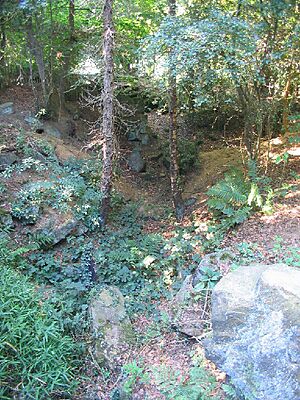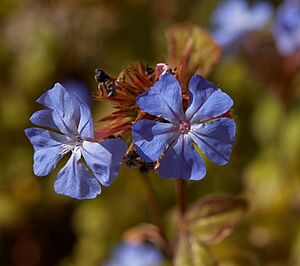Ellen Willmott facts for kids
Quick facts for kids
Ellen Ann Willmott
FLS VMH
|
|
|---|---|
 |
|
| Born | 19 August 1858 Heston, Middlesex, UK
|
| Died | 27 September 1934 |
| Nationality | British |
| Occupation |
|
Ellen Ann Willmott (born August 19, 1858 – died September 27, 1934) was a famous English gardener and plant expert. She was a very important member of the Royal Horticultural Society. In 1897, she received the first-ever Victoria Medal of Honour. This special award is given to top British gardeners.
Ellen Willmott was known for growing an amazing number of plants, over 100,000 different types! She also helped pay for trips to find new plants around the world. Because she was wealthy, she bought big gardens in France and Italy. These were in addition to her main garden at Warley Place in Essex, England. More than 60 plants have been named after her or her home, Warley Place.
Contents
Early Life and Gardens
Ellen Willmott was born in Heston, Middlesex, England. She was the oldest of three daughters. Her father, Frederick Willmott, was a lawyer. Her family loved gardening.
In 1875, her family moved to Warley Place in Great Warley, Essex. This property had 33 acres (about 134,000 square meters) of land. This became Ellen's home for her whole life. The family worked together to make the gardens beautiful. When Ellen turned 21, her father let her create a special alpine garden. This garden included a man-made gorge and a rockery.
Later, Ellen received a large amount of money from her godmother, Helen Tasker. This allowed her to buy her first garden property in France in 1890.
A Passion for Plants
When her father passed away, Ellen inherited Warley Place. She continued to make the gardens even better. She loved collecting and growing plants. It's believed she grew more than 100,000 different kinds of plants! Her garden had many special features. These included a conservatory, glasshouses, and a system to water plants. There was also a rock garden designed like an alpine gorge, a lake for boating, and a glass-covered cave for delicate ferns. She planted tens of thousands of bulbs. These bulbs would bloom in beautiful, natural-looking groups.
Ellen Willmott hired many gardeners, sometimes up to 104 people! She was known for being very strict. She would supposedly fire any gardener who let a single weed grow among her flowers. She only hired men to work in her garden.
She also spent a lot of money on her passion. In 1905, she bought a third garden estate in Ventimiglia, Italy. Ellen used her wealth to pay for plant-hunting trips to places like China and the Middle East. New plant species found on these trips were often named after her. For example, she sponsored trips by Ernest Henry Wilson. He named plants like Ceratostigma willmottianum, Rosa willmottiae, and Corylopsis willmottiae after her. Over 50 plant types were named in honor of her or her gardens.
Awards and Achievements
Ellen Willmott joined the Royal Horticultural Society (RHS) in 1894. She quickly became an important member. She was chosen for committees that focused on specific flowers like narcissus and lily. She also helped convince Sir Thomas Hanbury to buy land at Wisley. This land became the famous RHS Garden, Wisley. She was made a trustee of the RHS Gardens in 1903.
In 1897, Ellen Willmott and Gertrude Jekyll were the first two women to receive the Victoria Medal of Honour. This award was created that year to celebrate Queen Victoria's 60th year as queen. In 1904, Ellen was one of the first women to become a fellow of the Linnean Society of London. She also received other important awards for her work with plants.
Ellen Willmott also wrote two books. Her first book, Warley Garden in Spring and Summer, came out in 1909. Her most famous work was The Genus Rosa, published between 1910 and 1914. This book included 132 beautiful watercolor paintings of roses by Alfred Parsons. These paintings are now kept in the Lindley Library in London. Famous visitors like Queen Mary and Queen Alexandra visited her at Warley Place.
Other Interests
Besides her amazing work with plants, Ellen Willmott had other hobbies. She was interested in photography and a special type of woodturning called ornamental turning. In 1932, she gave some of her turning tools, examples of her work, and many photos of plants to the History of Science Museum, Oxford.
Later Life
Ellen Willmott spent a lot of money during her life. This caused her to have money problems later on. She had to sell her gardens in France and Italy. She even had to sell some of her personal belongings.
She passed away in 1934 at the age of 76. After her death, Warley Place was sold to help pay off her debts. The house was torn down in 1939. Today, part of the land is a nature reserve managed by the Essex Wildlife Trust. The rest is cared for as an abandoned garden.
See also
In Spanish: Ellen Willmott para niños





